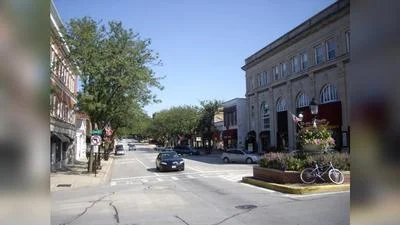Bail reform has already come in various forms: to Cook County including Chicago, plus New York City, San Francisco, Los Angeles, and other U.S. cities. Now a souped-up version is coming statewide in Illinois. Other states should be on high-alert in coming months and years for bail reform initiatives because buyer’s remorse will be part of the package whether proponents want to admit it or not. This is a key takeaway from a new issue brief: “Bail Reform in Chicago: Un-Solving Problems in Public Safety and Court Financing” from the Manhattan Institute by University of Cincinnati professor John Paul Wright. He uses Cook County and Illinois as his primary example.
Wright argues that criminal justice reformers who backed bail changes in Cook County and the SAFE-T Act in Illinois callously ignore the harmful impacts on lower-income, crime-prone minority communities. Says Wright, “The costs of crime are borne on the backs of individuals, families, and businesses that all too often occupy the least privileged neighborhoods in society.”
Cook County is already paying the price due to bail reform enacted under Chief Judge Timothy Evans in late 2017. Up to November 19 this year, the crime website CWBChicago reports there have been 87 alleged victims of people facing trial in Chicago just for top-tier violent crime or weapons felonies – and who were out on bail under relaxed rules instituted in by Evans 2017. That includes 49 alleged victims of killings or shootings or attempts to kill or shoot them. More than 15,000 crimes of all sorts have been committed by Cook County pretrial defendants out on bail since bail reform was instituted in 2017, but that amount is lowballed dramatically because most crimes go unreported and arrest rates in Chicago are so low.
Wright in the issue brief says bail reform in Cook County is “unsolving” crime problems and that the SAFE-T Act’s end of cash bail and its sharp limitation of pretrial detention will worsen crime victimizations – particularly for at-risk communities that can stand it the least.
Wright does not in his paper address some of the broader causes of crime in Chicago: that four out of five black children are born to unmarried mothers; that K-12 public education fails to deliver proficiency in reading and math to about 90 percent of black students; and that sentencing in Cook County courts is weak and systemically immune from transparency and accountability. Wright does however accent the devastating marginalization by policy-makers of minority victims of crimes facilitated by bail reform.
Here are four key takeaways from Wright’s policy brief.
Takeaway #1: Bail reform is founded on a myth, and cash bail is an important deterrent.
Bail reform advocates in Cook County and nationwide contend many hundreds of thousands of defendants are held at length because of inability to make cash bail, but this is simply not true. Citing a study of New York City cash bail payment timeframes for defendants, Wright notes, “of those who were arrested by New York City police in 2018 and had bail set, 13% made bail on their first court appearance. Of the remaining 87%, 45% would make bail within two days, 70% would within seven days, and almost 90% would within 30 days.”
Wright also cites a federal Bureau of Justice Statistics report which found that in the 75 largest U.S. counties from 1990 to 2004, “only 6% of defendants were held without bail. Of those released on bail, 45% were released within one day, 76% were released within a week, and 92% within a month.” Wright concludes “contrary to the claims of reformers” pretrial detainees are not held “simply because they are poor and cannot make bail.”
Wright further notes that cash bail has always played an important deterrent role in the criminal justice process, something he believes is being swept aside now in Cook County and soon, Illinois. He writes, “Bail…protects witnesses and victims of crime from retaliation and intimidation, incentivizing cooperation with justice officials…Many arrestees never see a prison or jail cell, and even those who cannot immediately make bail are rarely held for long. The inconvenience that can accompany bail is the only real punishment many will experience…the bail process and the associated difficulties…serve as an important but overlooked deterrent…”
Takeaway #2: The trade-offs of bail reform in Cook County and the SAFE-T Act are not properly balanced. Victims of resulting additional crimes will pay too high a price.
Wright acknowledges that under bail reform crimes committed by pretrial defendants are relatively few in percentage terms but argues, “…it doesn’t take large-percentage changes in crime to have a dramatic impact on community safety in general, or to have a devastating impact on victims’ lives specifically. This is the trade-off that every policymaker must face: changing a crime policy like bail may benefit defendants, but it will also kill, maim, and harm others. Balancing this reality is not easy; but in the era of criminal justice reform, merely recognizing this reality has become politically challenging.”
The question is, which black lives matter? Just the ones taken by police? Because that is a tiny fraction of those lost to the criminal class.
Takeaway #3: The SAFE-T Act in Illinois is a next-level threat to public safety, far worse than Cook County bail reform.
Wright also notes that compared to Cook County bail reform, the SAFE-T Act is a next-level threat to public safety. It’s statewide and more sweeping. He writes, “The SAFE-T Act…goes well beyond Judge Evans’s comparatively modest reforms by freeing almost everyone immediately after arrest. Under Judge Evans’s reforms, defendants could still be held without bond — especially if they represented a threat to the community. The SAFE-T Act, however, is remarkable in that it more stringently limits the ability of prosecutors and judges to protect the community from dangerous individuals.”
Wirepoints has reported how the Act blocks judicial discretion to detain before trial either felony weapons defendants or those charged with forcible but probationable felonies such as aggravated batteries, burglaries, robberies and arsons.
Takeaway #4: The SAFE-T Act is both hypocritical and dismissive of impacts on minorities.
Addressing Cook County bail reform and particularly the effective end of pretrial detention under the SAFE-T Act, Wright attacks the dismissiveness and hypocrisy of criminal justice reform advocates who would never tolerate crime spikes in their own safer communities as a result of the reforms they enact but are ready to visit misfortune on communities of color.
“Before writing off marginal increases in crime and violence…consider that the devastating consequences of violent crime are almost never paid for by…reform advocates. The costs of crime are borne on the backs of individuals, families, and businesses that all too often occupy the least privileged neighborhoods in society. Fifty homicides in poor, crime-ridden neighborhoods is a travesty. Fifty in the neighborhoods populated by advocates, judges, and politicians would be untenable.”
A wake-up call for lawmakers in the Fall 2022 veto session
The issue brief by Professor Wright represents an outside and dispassionate analysis of the serious risks already borne by black communities in Cook County from bail reform and future risks which will fall unevenly on black communities statewide under the SAFE-T Act. It should serve as a wake-up call to lawmakers in Springfield who will still be able to amend the Act after Thanksgiving in the fall veto session.
Wright’s suggestions for fixing the act includes a call to identify certain serious felonies for which there is preliminary assumption that pretrial detention is the favored course – rather than something to be avoided except in rare circumstances. He argues, “To ameliorate public safety risks, legislators could, as they have done in New Jersey, include a list of offenses for which exists a presumption of pretrial remand. The presumption could be challenged by the defense at a hearing, but this tool alone could be sufficient to offset some of the problems currently experienced in Chicago.”
The report makes clear something that policymakers here have shamefully downplayed: all black lives and victims of crime matter. Not just those very, very few taken by police from an unarmed subject.
But the House Black Caucus of Illinois drove passage of the 764-page SAFE-T Act. Wright’s issue brief captures the shame that criminal justice reformers should feel – but don’t – for marginalizing black lives and black victims.





 Alerts Sign-up
Alerts Sign-up